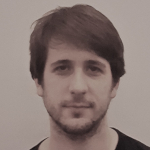
 Matthew Thorpe
Matthew Thorpe
Lecturer in Applied Mathematics
What are your research interests?
I work on the theoretical aspects of machine learning where I can apply methods from applied mathematics such as partial differential equations and the calculus of variations. For example, I’m interested in variational limits from problems that arise from graph-based semi-supervised learning algorithms. I also have an interest in the connections between neural networks and differential equations and applying optimal transport distances to applications in signal and imaging.
What is the focus of your current research?
Mainly I am working on large data consistency proofs for semi-supervised learning algorithms. I am looking for when these methods are asymptotically well-posed and ill-posed. In the latter case I am trying to identify the bias’s in order to develop new methods and algorithms that are more robust.
What are some projects or breakthroughs you wish to highlight?
One particular highlight would be developing a new algorithm with state of the art performance in semi-supervised learning with very low label rates. With collaborators I was able to characterise and correct for the bias in Laplace learning. This lead to a new method, called Poisson learning, which generally outperforms other methods when only a very small set of features are labelled.
What memberships and awards do you hold/have you held in the past?
I am a fellow of the Alan Turing Institute, a partner in the NoMADS (nonlocal methods for arbitrary data sources) programme, and a collaborator in the AIX-COVNET group which is developing artificial intelligence solutions to aid the diagnosis/prognosis of covid-19.
What is the biggest challenge in Data Science and AI right now?
In my opinion this would be to understand the interpretability of machine learning algorithms (particularly in deep learning). Answering this question would help us to understand what machine learning algorithms are learning. This not only helps us to understand and have confidence in such algorithms but can also tell us where the algorithms may be vulnerable to failure.
What real world challenges do you see Data Science and AI meeting in the next 25 years?
I see data science and AI becoming much closer integrated into decision making processes. I believe it will become the norm for business and engineering decisions to be made with support from data science and AI. This is already true for large companies and businesses. I believe tools and services will be developed over the next 25 years to enable even small businesses to have the tools necessary for data driven decisions.
